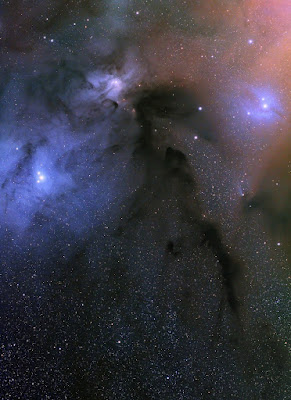
Well, I went and done it -- I went ahead and bought a "true"
astro camera to compliment my
FSQ scope. After learning the ropes with my little
QHY8 one-shot color camera (a really nice little camera by the way) I decided to step-up to the "big league" with the
STL-11000M camera from Santa Barbara Imaging Group.
The
STL is mono large chip (11
megapixel) that images through a built-in filter wheel to record color data in a series of passes. Why mono? Well, the mono chips are much more sensitive, and
separate color passes provide much greater fidelity (think composite video vs. component video). Also this camera has much deeper wells than the
QHY8, which translates into increased dynamic range, for resolving all those faint details. It also has programmable cooling and other features.
Processing the
LRGB images (separate Luminance, Red, Green, Blue) is much more daunting than simple one-shot color. There is at least 4 times as much data, and additional calibration frames are a must. But the end results speak for themselves. Although this image is a quick test, I am already excited about the differences I am seeing in the data (and you know you're a nerd when "data" excites you).
This image is from the Gamma
Cygni region in the Cygnus constellation. It is a large complex of Hydrogen Emission nebulosity. Hence, I shot my luminance data through the HA filter of my new camera (another boon to this type of camera -- just program the filter wheel to whatever filter you want, then bang away).
Anyway, this is my "first light" image -- the first time this camera has seen starlight. This is also my first attempt at using a new program to process my data (
CCD Stack), and of course the first time I have tackled a
LRGB image. But I must say, I am very happy with my progress thus far (and yes, it is also a bit nerdy to say "thus").
Image stats:
FSQ 106EDX f/5
STL-11000m -13C
Ha,R,G,B
60x10x10x10
CCD Stack, Cs3
 Well, my astrophotographic offerings have been relatively slim the last few months. It seems whenever I have a chance to image, the weather reports LOOK good, but then it all falls apart as soon as I drive several hours, set up all my gear, then hit "start". Right on cue the clouds roll in -- just a run of bad luck : (
Well, my astrophotographic offerings have been relatively slim the last few months. It seems whenever I have a chance to image, the weather reports LOOK good, but then it all falls apart as soon as I drive several hours, set up all my gear, then hit "start". Right on cue the clouds roll in -- just a run of bad luck : (





































 :
:












 I took these images in the park across the street from my house, using my Nikon D-80 and Nikor 10.5mm Fisheye lens. It is a 3 second F/7 exposure at ISO 800.
I took these images in the park across the street from my house, using my Nikon D-80 and Nikor 10.5mm Fisheye lens. It is a 3 second F/7 exposure at ISO 800.



